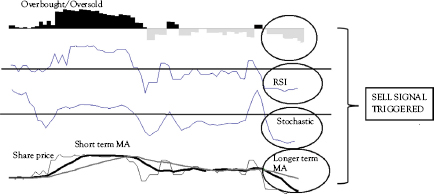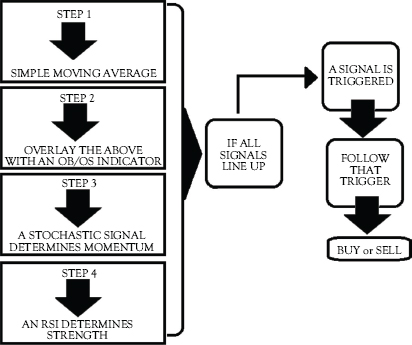I think and think for months and years. Ninety-nine times, the conclusion is false. The hundredth time I am right.
—Albert Einstein (1879–1955)
Developer of theories of relativity and winner of
Nobel Prize for Physics in 1921
Conclusion
These three volumes have taken you through a host of variables to enable you to create an effective trading methodology and strategy. It is important to see, however, that you take from these volumes only what you need to design your own workable trading system. There is a myriad of financial and trading books available to you to continually improve your skills. For instance, find books on accountancy. Not in the sense of drafting financial statements, but rather on how to assess income statements and balance sheets.
There is no harm in finding out how to read a company’s accounts, after all, Earnings Per Share (EPS) is derived from the statements, which, in turn, ultimately results in the company’s share price rising or falling.
“Is there a simple system to trade today—without reading these three volumes again?”
Against my better judgment, the answer is yes, and relates specifically to those using a swing trading system:
Swing trading requires, in my opinion, extreme patience, as you need to combine fundamental analysis with daily bar charts to help to time your market entry. In addition, most swing traders are well-capitalized, which allows them to diversify among different global markets, and thus reduce risks of declines in any single market. Being well-capitalized means, of course, that you have substantial funds available to you to trade.
• A daily chart pattern system.
• A system that has simple moving averages.
The aforementioned moving averages can be used to help you to quickly identify new trends. The simple signal is:
Trading signal trigger |
Moving average crossover |
Buy |
When the shorter-term indicator crosses the longer-term indicator upward. |
Sell |
When the shorter-term indicator crosses the longer-term indicator downward. |
Three more indicators are needed:
• Firstly, you will need to implement a stochastic signal to assist you to see:
![]() if the signal indicates that the securities’ momentum is still strong enough to continue.
if the signal indicates that the securities’ momentum is still strong enough to continue.
![]() when the position becomes oversold or overbought.
when the position becomes oversold or overbought.
• Secondly, use the relative strength index (RSI) indicator to confirm that securities’ strength.
• Thirdly, you need to decide on how much you are willing to make or lose per trade. This really means setting up an exit and entry point.
The following is an example of the aforementioned criteria:

The diagram indicates that the shorter-term moving average (MA) has crossed the longer-term one in a downward move, triggering a possible Sell signal. This is confirmed by the stocastic indicator, warning of a slowing down of momentum and weakening strength via the RSI. The OB or OS indicator is the final confiormation that a sell is indicated.
You can see that your investment criteria have been met, with all your predetermined indicators (MA crossover, stochastic, and RSI), all pointing to a Sell signal. Yet, do you know how many novice traders still ignore these and hold on in the hope that the market will turn?
My analysis indicates that more than 80 percent of new traders hold onto losing shares.
The final step in the preceding graph is to include a buy and sell entry point. You can use resistance and support lines to do this. Make a note of your entry price, stop loss, and exit strategy.
To summarize:

The preceding is just another way to say that trading systems do not have to be complicated or involve dozens of indicators. Remember that you created your trading system, so not following it can only mean that you are lazy; the system does not work or that you are not serious about being a trader.
Be disciplined and trust your system and your abilities.
It has taken many pages to get to this final message, and I hope that it has been a worthwhile journey. My message is simple: if you have a well-designed system and are disciplined and serious about your new career as a trader, then you must follow your own plans and strategies. For instance, it is useless to say that you will trade a new company listing, called an initial public offer (IPOs), and then decide to trade small caps. If you keep changing the parameters of your strategies, you will end up as the loser and much poorer.
If it helps you as a trader, let me finish this volume with a few of the disciplines I have adopted over the years:
• In the share market, only buy ordinary shares and ignore all other types of marketable securities. I am not interested in buying preference shares, even if they offer a higher dividend—I am not trading shares for their dividend, but for capital growth. I seldom hold shares for long enough to earn a dividend.
• I reduce my risk of trading by:
![]() Having a balanced portfolio.
Having a balanced portfolio.
![]() Diversifying across at least three contra-cyclical sectors.
Diversifying across at least three contra-cyclical sectors.
![]() Never holding more than 12 shares in my trading portfolio.
Never holding more than 12 shares in my trading portfolio.
![]() Day trading stocks are closed every night.
Day trading stocks are closed every night.
![]() Never putting more than 2 percent of your entire capital into any single investment or trade.
Never putting more than 2 percent of your entire capital into any single investment or trade.
![]() Having a solid entry point and exit strategy. This means that, at times, I take profits too early or sell a little late, but I keep to my strategy, and thus never (I stress) never have emotions of greed or fear.
Having a solid entry point and exit strategy. This means that, at times, I take profits too early or sell a little late, but I keep to my strategy, and thus never (I stress) never have emotions of greed or fear.
![]() Once I have completed analysis, I carry out a trade without hesitation.
Once I have completed analysis, I carry out a trade without hesitation.
![]() I never buy on tips or rumors, ever!
I never buy on tips or rumors, ever!
![]() My personal final filter is to buy shares that generate more cash per share than share price.
My personal final filter is to buy shares that generate more cash per share than share price.
• Believing in your strategy does not equate to being flexible. Markets and companies change, and at times, change rapidly. When companies make unforeseen statements, be prepared to take action and switch trades, often from one industry to another.
• Educate yourself: Take time to improve your investment knowledge through books, workshops, and keeping up to date on industries and companies by reading investment papers regularly.
• Keep an eye on IPOs: I use the strategy and valuation techniques outlined in this volume to pick up quality new investments.
• Volatile shares are great for short-term trades: Look at companies that are tightly held for opportunities to buy when they have been slammed by market conditions. If a company is 80 percent controlled by a blue-chip institution, that organization often steps in and acquires the share at the lower value, which is a short-term trading opportunity for you.
There is a great deal of truth in the old saying that life is a gamble. Every action carries its own risks. Every trade and investment brings you face to face with a specific risk. Those who are thinking about trading as a career have to accept that you cannot sit back and accept (or think) that trading is easy.
You can, of course, turn to a mentor to help you achieve your goals in an orderly manner. While markets change and industries move in cyclical manners, I can always rely that properly selected shares or other forms of securities will offer value.
You have to be patient and serious. This is simply not an industry to be taken lightly, but it can be a highly profitable one.
